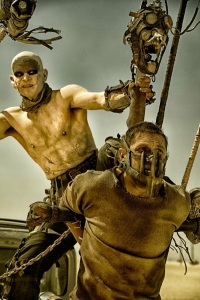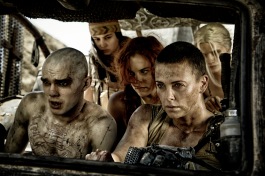
Jutting out over the IJ like a pier of industrial wasteland, Het Stenen Hoofd is all dirt and dry grass. This evening, small marquees line the urban shore, selling bottled beer, pulled pork baps and falafel wraps. From the food trucks, a few benches scatter inwards towards the centre of the island where a mass of deckchairs are lined like mini trebuchets, firing the gaze of a few hundred film fans at a large screen. The screen is a tarpaulin stretched over and fastened to several stacked freight containers. This is Pluk de Nacht, Amsterdam’s annual open-air film festival.
I arrive and do everything in wrong order. Having spent all day tramping around the city (an unstoppable force, walking bicycle-speed) visiting museums and following canals to nowhere in the rain, I’m really hungry. After a quick rotation-on-the-spot, the pulled pork tent wins my tired ‘how much food for how few euros’ calculation and two minutes later, I’m one-handed trying to hire and then assemble my deckchair.
The very best spots have been taken but it’s not a disaster. The crowd is oval-shaped so I can’t pitch as far back as I’d like without being pushed too left-of-centre. I scan the crowd, trying to work out the viewing trajectory from deckchair to screen when set at different angles. I don’t want to be horizontal but perhaps I can sit closer to the front – therefore closer to the centre – but set it up so as to be more lying than sitting and still get a reasonable angle. I pick my spot, sandwich still in hand, and fumble around for far too long before the straw-hatted deckchair master strides over and sets me up in half a second.
Now I’m thirsty. But I’m on my own. Can I risk leaving my seat? I have a bag. Can I risk leaving my bag on my seat? I do. Everything’s fine. I buy two bottles of Vedett (which I’d almost get a taste for in the end) and return.
A game of the arcade classic Frogger is being shown on the screen. No – played on the screen – by at least 20 members of the audience who have signed in on their phones through the URL at the top of the screen. Groans and cheers rise and fall here and there as the gamers make a mad dash through the traffic, over the logs toward the lily pads.
It’s getting darker and, after another strange on-screen event, some kind of virtual reality guessing game, a 60-second countdown appears on the screen and everyone settles in.
Sexy Laundry
 The pre-feature short is a Claymation made by Polish director Izabela Plucinska, based on a stage play by Canadian Michele Riml. It is an extended comedy sketch about a middle-aged couple who, bored of each other and each other’s bodies, spend a night in a posh hotel to try and rekindle the fire of their diminishing romance. It’s funny. The hotel room is a Twin Peaks-inspired black, white and red purgatory of absurd stop/start sex. The clay of the couple’s bodies is detailed and grotesque. Plucinska is conservative with the material, remaining mostly on the side of realism so that when it does stray into the absurd (body parts knead and stretched into all kind of shapes), it really draws the laughs.
The pre-feature short is a Claymation made by Polish director Izabela Plucinska, based on a stage play by Canadian Michele Riml. It is an extended comedy sketch about a middle-aged couple who, bored of each other and each other’s bodies, spend a night in a posh hotel to try and rekindle the fire of their diminishing romance. It’s funny. The hotel room is a Twin Peaks-inspired black, white and red purgatory of absurd stop/start sex. The clay of the couple’s bodies is detailed and grotesque. Plucinska is conservative with the material, remaining mostly on the side of realism so that when it does stray into the absurd (body parts knead and stretched into all kind of shapes), it really draws the laughs.
Interval
The sky is black, the crowd is merry and a new participatory game has popped up on the screen. It’s a genuinely fascinating recreation of Loren Carpenter’s Pong experiment!

Half of the audience controls the left paddle and the other half the right. Somehow, through choosing up and down on their phones, each team has to organize its way to successfully controlling its paddle. While it’s safe to say that this attempt was much less of a triumph than Carpenter’s 1991 version (put that down to either the shorter game length or the questionable level of the sobriety of its participants), a good time, maybe too good a time, was had by all.
Illegitimate
 The main feature is a Romanian film about the moral complications surrounding abortion and incest. Obviously, it’s very delicate and intense subject matter and it took a while to wrap my head around the film’s presentation of the cultural history of Romania and its changing norms/taboos. Not being Romanian, it is impossible to judge how successfully this is accomplished but, from a dramatic standpoint, the opening dinner table scene (which breaks out into a fierce family argument revolving around the father’s complicity in some of Ceaușescu’s more draconian policies in communist Romania) is captivating and certainly conjures a palatable atmosphere that I quickly bought into, however truth-skewed it might actually be.
The main feature is a Romanian film about the moral complications surrounding abortion and incest. Obviously, it’s very delicate and intense subject matter and it took a while to wrap my head around the film’s presentation of the cultural history of Romania and its changing norms/taboos. Not being Romanian, it is impossible to judge how successfully this is accomplished but, from a dramatic standpoint, the opening dinner table scene (which breaks out into a fierce family argument revolving around the father’s complicity in some of Ceaușescu’s more draconian policies in communist Romania) is captivating and certainly conjures a palatable atmosphere that I quickly bought into, however truth-skewed it might actually be.
The family tension results from the fact that, during Ceaușescu’s reign, the father (Victor) informed the authorities of women who were seeking abortions, the illegality of which (abortion was against the law before 1989) led many women to die during botched underground operations. The children of the family – living as they do in more enlightened times – are furious when they learn about this and most ostracise Victor, who is baffled at the unsympathetic reaction of the younger generation to his actions during a brutal period of their country’s history.
After the first 20 minutes, a slow trickle of people began folding up their deckchairs, handing them in and wandering off. Were the audience finding this film a bit tricky? I had heard a few sniggers during the awkward sibling sex scene but the night was getting gradually colder and perhaps these leavers were simply as unwilling as me to pay to hire a blanket… It is difficult to know how common an issue this is in Romania and the film doesn’t help in clearing up the confusion. On the one hand, the brother and sister are aware how horrified the rest of the family and their community will be when they learn of their relationship and the resultant pregnancy. On the other, the brother (unfortunately named ‘Romeo’) is convinced that they can build a family together in these liberated times. Is this a country genuinely coming round to the idea of incest? Or is this just a lovesick boy (perhaps ‘Romeo’ is apposite after all) getting confused and carried away?
 Happy to admit ignorance, I decided to trust the film at face value and take the ride. I enjoyed it. The performances are generally strong – especially from the two main players, Adrian Titieni and Alina Grigore who play Sasha and her father. The story may be a little too neat for some – the way that the sins of the father are rehashed and then revisited upon him by his children. However, Illegitimate isn’t as far a cry from the hyper-real aesthetic of other contemporary Romanian cinema as it may seem. While its story might unfold like a Greek Tragedy, there is some grit about the dialogue and camerawork. This is largely down to the attitude of its director Adrian Sitaru who enforced a strict one-take-only rule on each scene while allowing his cinematographers to improvise their camera movement and inviting the actors to freeform their dialogue around a rough story structure.
Happy to admit ignorance, I decided to trust the film at face value and take the ride. I enjoyed it. The performances are generally strong – especially from the two main players, Adrian Titieni and Alina Grigore who play Sasha and her father. The story may be a little too neat for some – the way that the sins of the father are rehashed and then revisited upon him by his children. However, Illegitimate isn’t as far a cry from the hyper-real aesthetic of other contemporary Romanian cinema as it may seem. While its story might unfold like a Greek Tragedy, there is some grit about the dialogue and camerawork. This is largely down to the attitude of its director Adrian Sitaru who enforced a strict one-take-only rule on each scene while allowing his cinematographers to improvise their camera movement and inviting the actors to freeform their dialogue around a rough story structure.
This mishmash of approaches might make its morality a bit of a mess but this probably serves Illegitimate well in the end. Its strange twilight atmosphere leaves an audience without a secure footing from which to condemn or ridicule a dysfunctional family making the best of their own mess.
Pluk De Nacht is excellent (and free). It runs every summer in Amsterdam, with shorter programmes also taking place in Utrecht and Arnhem. Visit http://www.plukdenacht.nl/en/ for more information.

 Light and mournful, like the omnipresent jazz piano glued under most scenes, Woody Allen’s latest film revisits many of his favourite concerns: the trappings of class, the neurosis of society, the impossibility of love and the gentle meaninglessness of it all. It doesn’t pang as sharp as Annie Hall nor bite as hard as Blue Jasmine but Café Society is charming from beginning to end.
Light and mournful, like the omnipresent jazz piano glued under most scenes, Woody Allen’s latest film revisits many of his favourite concerns: the trappings of class, the neurosis of society, the impossibility of love and the gentle meaninglessness of it all. It doesn’t pang as sharp as Annie Hall nor bite as hard as Blue Jasmine but Café Society is charming from beginning to end. Shot by Vittorio Storaro, the film has a depth of colour and light that really stands out. Most films with this little shadow seem overlit and washed out whereas this has a genuine richness. The sunlight pours gold through windows, the Hollywood exteriors are an even sepia, the night time pool parties have a pretty warm/cool contrast and the New York café scene has the worn coldness of old folk album covers. It’s great to look at and is one of many ingredients that make the film such an easy watch.
Shot by Vittorio Storaro, the film has a depth of colour and light that really stands out. Most films with this little shadow seem overlit and washed out whereas this has a genuine richness. The sunlight pours gold through windows, the Hollywood exteriors are an even sepia, the night time pool parties have a pretty warm/cool contrast and the New York café scene has the worn coldness of old folk album covers. It’s great to look at and is one of many ingredients that make the film such an easy watch.
















